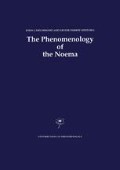Abstract
Edmund Husserl was notable for his insistence that the primary work of the philosopher was finding things. Most importantly, the philosopher has the task of finding the “things” that philosophers themselves talk about, in order to see if they really are as represented in philosophical discussions. The recommended flight to the “things themselves,” for which Husserl became famous, is precisely a flight originating from how those things had come to be represented. Once this flight is accomplished, we then have the task of clearing up terminology to fit things as they are. Only so can the intersubjectivity that characterizes scientific work be achieved. As we do our philosophical work we cannot be forever staring at essences. We want to think as well, and to interact with each other about our subject matter. Thus:
In phenomenology, which aims to be nothing else than essence theory confined to pure intuition, we accordingly carry out direct intuitions of the essences given within samples of transcendentally pure consciousness, and we fix those intuitions conceptually, that is, terminologically. Science is possible only where results of thought are retainable in the form of knowledge and are available to further thinking in the form of a system of assertions: assertions which are intelligible as to logical sense, but can be actualized without the clarity of underlying presentations, and thus without insight and in the manner of the [mere] judgment.... To this end it is necessary that words and sentences which are identical be univocally tied to certain intuitively graspable essences that make up their ‘fulfilling sense.’1
Access this chapter
Tax calculation will be finalised at checkout
Purchases are for personal use only
Preview
Unable to display preview. Download preview PDF.
References
Ideas I,subsection 66, BG 193. I have provided my own translations of Husserl’s texts, sometimes translating rather freely for emphasis. My references are by subsections of the works referred to, and to an English translation where available. ‘BG“ followed by a number indicates the page number of the hardbound edition of the Boyce Gibson translation of Ideas I. I have worked from the 1950 German edition of this text, i.e. Ideen z einer reinen Phänomenologie und phänomenologische Philosophie. Erstes Buch. Allgemeine Einfïihrung in die reine Phänomenologie,ed. Walter Biemel, Husserliana III (Den Haag: Martinus Nijhoff, 1950).
Edmund Husserl, Philosophie der Arithmetik, ed. Lothar Eley, Husserliana XII ( Den Haag: Martinus Nijhoff, 1970 ), p. 119.
Edmund Husserl, Logische Untersuchungen. Zweiter TeiL Untersuchungen zur Phiinomenologie und Theorie der Erkenntnis (Halle a. S.: Max Niemeyer, 1901 ).
Edmund Husserl, Die Idee der Phänomenologie: Fünf Vorlesungen, ed. Walter Biemel, Husserliana II (Den Haag: Martinus Nijhoff, 1958), p. 71; The Idea of Phenomenology, trans. W. P. Alston and George Nakhnikian ( The Hague: Martinus Nijhoff, 1973 ), p. 56.
A Critical Study of Husserl and Intentionality,“ Journal of the British Society for Phenomenology 19 (1988): 186–198, 311–322.
Hua III, §97, BG 283. Husserl uses the term “reelle” as early as his first publication in 1887 to describe the stuff that goes into the makeup of a representation; cf. Hua XII, 324. I feel certain that he does not originate this usage, but have been unable to do the research into its background.
See Edmund Husserl, Erfahrung und Urteil: Untersuchungen zur Genealogie der Logik,ed. Ludwig Landgrebe (Hamburg: Felix Meiner Verlag, 1972), 05 as well as the final paragraphs of the “Introduction” to Ideas I; Hua III, 6–7; BG 45.
See J. P. Moreland, “Was Husserl a Nominalist,” Philosophy and Phenomenological Research 49 (1989): 661–674; cf. also my paper “Is Derrida’s View of Ideal Being Rationally Defensible” to appear in a volume edited by Lester Embree on phenomenology and deconstruction, from Kluwer in 1992.
See my Logic and the Objectivity of Knowledge (Athens, OH: Ohio University Press, 1984), chap. I.
Author information
Authors and Affiliations
Editor information
Editors and Affiliations
Rights and permissions
Copyright information
© 1992 Springer Science+Business Media Dordrecht
About this chapter
Cite this chapter
Willard, D. (1992). Finding the Noema. In: Drummond, J.J., Embree, L. (eds) The Phenomenology of the Noema. Contributions to Phenomenology, vol 10. Springer, Dordrecht. https://doi.org/10.1007/978-94-017-3425-7_3
Download citation
DOI: https://doi.org/10.1007/978-94-017-3425-7_3
Publisher Name: Springer, Dordrecht
Print ISBN: 978-90-481-4207-1
Online ISBN: 978-94-017-3425-7
eBook Packages: Springer Book Archive

